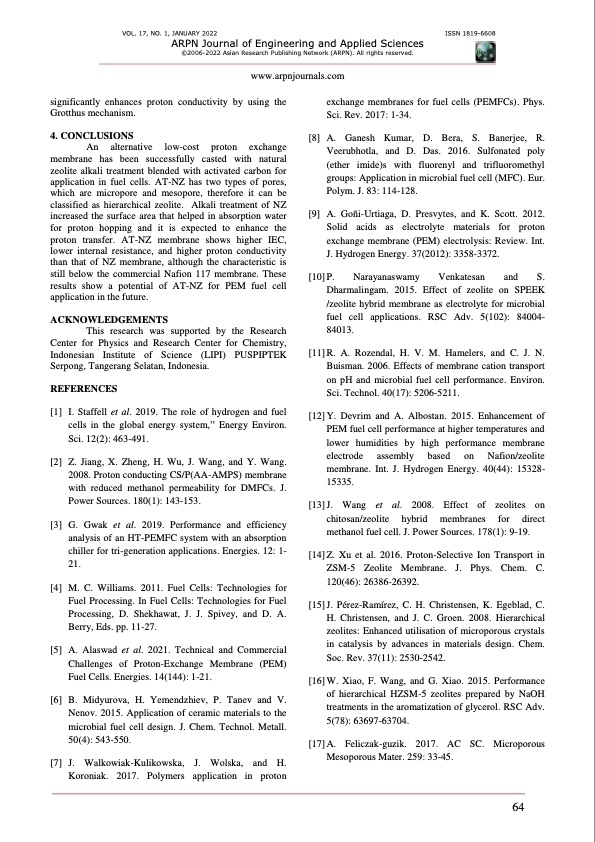
PDF Publication Title:
Text from PDF Page: 007
VOL. 17, NO. 1, JANUARY 2022 ISSN 1819-6608 ARPN Journal of Engineering and Applied Sciences ©2006-2022 Asian Research Publishing Network (ARPN). All rights reserved. www.arpnjournals.com significantly enhances proton conductivity by using the Grotthus mechanism. 4. CONCLUSIONS An alternative low-cost proton exchange membrane has been successfully casted with natural zeolite alkali treatment blended with activated carbon for application in fuel cells. AT-NZ has two types of pores, which are micropore and mesopore, therefore it can be classified as hierarchical zeolite. Alkali treatment of NZ increased the surface area that helped in absorption water for proton hopping and it is expected to enhance the proton transfer. A T -NZ membrane shows higher IEC, lower internal resistance, and higher proton conductivity than that of NZ membrane, although the characteristic is still below the commercial Nafion 117 membrane. These results show a potential of AT-NZ for PEM fuel cell application in the future. ACKNOWLEDGEMENTS This research was supported by the Research Center for Physics and Research Center for Chemistry, Indonesian Institute of Science (LIPI) PUSPIPTEK Serpong, Tangerang Selatan, Indonesia. REFERENCES [1] I. Staffell et al. 2019. The role of hydrogen and fuel cells in the global energy system,” Energy Environ. Sci. 12(2): 463-491. [2] Z. Jiang, X. Zheng, H. Wu, J. Wang, and Y. Wang. 2008. Proton conducting CS/P(AA-AMPS) membrane with reduced methanol permeability for DMFCs. J. Power Sources. 180(1): 143-153. [3] G. Gwak et al. 2019. Performance and efficiency analysis of an HT-PEMFC system with an absorption chiller for tri-generation applications. Energies. 12: 1- 21. [4] M. C. Williams. 2011. Fuel Cells: Technologies for Fuel Processing. In Fuel Cells: Technologies for Fuel Processing, D. Shekhawat, J. J. Spivey, and D. A. Berry, Eds. pp. 11-27. [5] A. Alaswad et al. 2021. Technical and Commercial Challenges of Proton-Exchange Membrane (PEM) Fuel Cells. Energies. 14(144): 1-21. [6] B. Midyurova, H. Yemendzhiev, P. Tanev and V. Nenov. 2015. Application of ceramic materials to the microbial fuel cell design. J. Chem. Technol. Metall. 50(4): 543-550. [7] J. Walkowiak-Kulikowska, J. Wolska, and H. Koroniak. 2017. Polymers application in proton exchange membranes for fuel cells (PEMFCs). Phys. Sci. Rev. 2017: 1-34. [8] A. Ganesh Kumar, D. Bera, S. Banerjee, R. Veerubhotla, and D. Das. 2016. Sulfonated poly (ether imide)s with fluorenyl and trifluoromethyl groups: Application in microbial fuel cell (MFC). Eur. Polym. J. 83: 114-128. [9] A. Goñi-Urtiaga, D. Presvytes, and K. Scott. 2012. Solid acids as electrolyte materials for proton exchange membrane (PEM) electrolysis: Review. Int. J. Hydrogen Energy. 37(2012): 3358-3372. [10] P . Narayanaswamy V enkatesan and S. Dharmalingam. 2015. Effect of zeolite on SPEEK /zeolite hybrid membrane as electrolyte for microbial fuel cell applications. RSC Adv. 5(102): 84004- 84013. [11]R. A. Rozendal, H. V. M. Hamelers, and C. J. N. Buisman. 2006. Effects of membrane cation transport on pH and microbial fuel cell performance. Environ. Sci. Technol. 40(17): 5206-5211. [12]Y. Devrim and A. Albostan. 2015. Enhancement of PEM fuel cell performance at higher temperatures and lower humidities by high performance membrane electrode assembly based on Nafion/zeolite membrane. Int. J. Hydrogen Energy. 40(44): 15328- 15335. [13]J. Wang et al. 2008. Effect of zeolites on chitosan/zeolite hybrid membranes for direct methanol fuel cell. J. Power Sources. 178(1): 9-19. [14]Z. Xu et al. 2016. Proton-Selective Ion Transport in ZSM-5 Zeolite Membrane. J. Phys. Chem. C. 120(46): 26386-26392. [15]J. Pérez-Ramírez, C. H. Christensen, K. Egeblad, C. H. Christensen, and J. C. Groen. 2008. Hierarchical zeolites: Enhanced utilisation of microporous crystals in catalysis by advances in materials design. Chem. Soc. Rev. 37(11): 2530-2542. [16]W. Xiao, F. Wang, and G. Xiao. 2015. Performance of hierarchical HZSM-5 zeolites prepared by NaOH treatments in the aromatization of glycerol. RSC Adv. 5(78): 63697-63704. [17] A. Feliczak-guzik. 2017. AC SC. Mesoporous Mater. 259: 33-45. Microporous 64PDF Image | ZEOLITE AND ACTIVATED CARBON FOR PROTON EXCHANGE MEMBRANE FUEL CELLS

PDF Search Title:
ZEOLITE AND ACTIVATED CARBON FOR PROTON EXCHANGE MEMBRANE FUEL CELLSOriginal File Name Searched:
jeas_0122_8819.pdfDIY PDF Search: Google It | Yahoo | Bing
CO2 Organic Rankine Cycle Experimenter Platform The supercritical CO2 phase change system is both a heat pump and organic rankine cycle which can be used for those purposes and as a supercritical extractor for advanced subcritical and supercritical extraction technology. Uses include producing nanoparticles, precious metal CO2 extraction, lithium battery recycling, and other applications... More Info
Heat Pumps CO2 ORC Heat Pump System Platform More Info
| CONTACT TEL: 608-238-6001 Email: greg@infinityturbine.com | RSS | AMP |